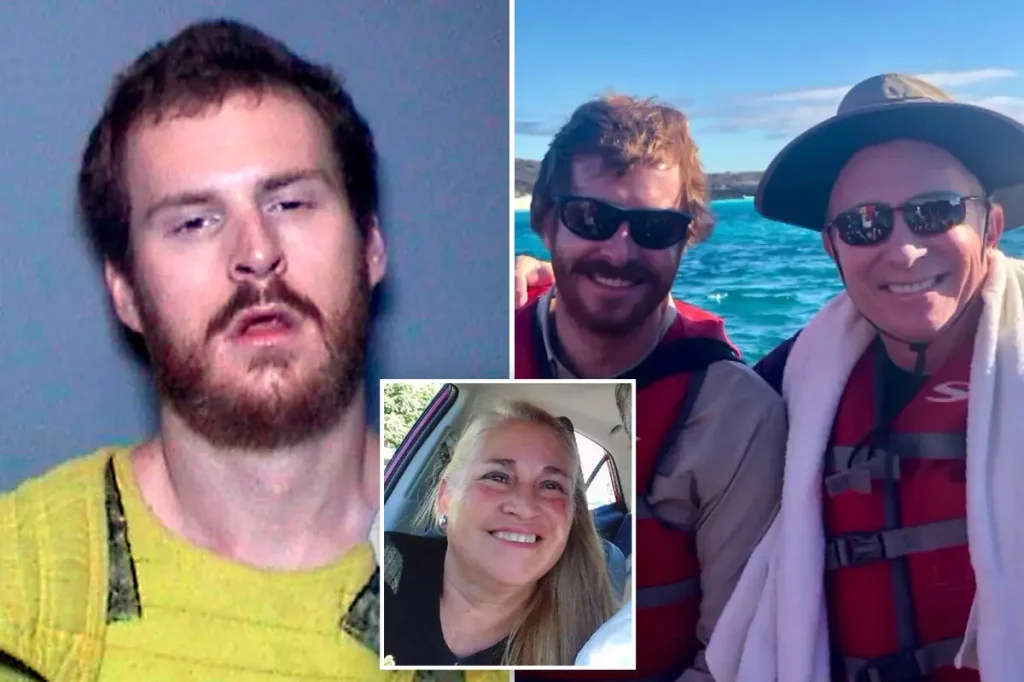A Dark Tragedy: Camden Nicholson’s Descent into Violence
In a tragic case that shocked Newport Beach, California, 34-year-old Camden Burton Nicholson was found guilty of first-degree murder for killing his parents, Richard and Kim Nicholson, along with their housekeeper, Maria Morse, in their $6 million gated community home in 2019. The jury’s verdict included the special circumstance of committing multiple murders, marking the conclusion of a heart-wrenching trial that revealed a family’s desperate struggle with mental health issues and addiction. The case has now entered a sanity phase to determine whether Nicholson was criminally insane during the killings, a decision that will determine whether he faces life in prison without parole or commitment to a mental health facility.
Camden’s story appears to be one of dramatic transformation and decline. According to testimony from his brother Cavin, Camden grew up as a seemingly happy and normal child. His life took a concerning turn after returning from a nine-month Mormon mission at age 19, when he began exhibiting signs of severe depression and unusual behavior. The once Boy Scout transformed rapidly, becoming involved with marijuana, steroids, pornography, and escort services. This behavioral shift deeply concerned his parents, who eventually hired a private detective to locate their son after he disappeared in December 2018, having stolen his mother’s car. The family dynamic was complicated, however, as Cavin testified that their mother suffered from borderline personality disorder and was verbally abusive, potentially contributing to Camden’s deteriorating mental state.
The situation escalated in February 2019 when Camden was found staying at a Marriott hotel, spending lavishly on his father’s credit card. After the card was declined, his parents urged him to return home and seek help. On February 5, Camden was placed on a 72-hour involuntary psychiatric hold, during which he told doctors his parents were “satanic” and would “try to find me and classify me as insane.” Despite doctors’ concerns about releasing him, Camden was discharged on February 11 at 4:11 p.m. and returned to the family home, where the tragic events would soon unfold. His parents had given him an ultimatum to check into a mental health and addiction facility, which prosecutors believe triggered his violent rampage.
The details of the murders reveal a disturbing sequence of events. Camden first confronted his 64-year-old father around 7 p.m. on February 11, stabbing him repeatedly in an attack that Deputy District Attorney Dave Porter emphasized must have been particularly horrifying because Richard would have recognized his killer as his own son. When his 61-year-old mother Kim returned home around 8:44 p.m., Camden attacked her with a 20-pound silver statue before stabbing her multiple times, leaving her body on the garage floor. The violence continued the following morning when Maria Morse, the family’s 57-year-old housekeeper, arrived for her cleaning shift. Camden attacked her with a knife, stabbed her repeatedly, slit her throat, and then concealed her body in a large plastic bin in the pantry—an act that prosecutors pointed to as evidence of his awareness of the wrongfulness of his actions.
In the aftermath of these horrific killings, Camden’s behavior suggested a disturbing disconnect from the gravity of his actions. He took his father’s car and embarked on a shopping spree in Santa Ana, spending hundreds of dollars at a marijuana dispensary and purchasing sex toys. This continued until he eventually drove to a medical center in Irvine and called 911, claiming he had killed his parents in self-defense because they were trying to kill him. Police conducted a welfare check at the Nicholson home and discovered the gruesome scene, with blood throughout the residence and three victims who had been fatally stabbed. The contrast between the brutality of his crimes and his subsequent casual spending spree paints a chilling portrait of a deeply troubled mind.
The case raises profound questions about mental illness, responsibility, and the challenges families face when trying to help loved ones with serious psychological problems. Prosecutor Dave Porter acknowledged that Camden may have suffered from mental illnesses but noted he had never been diagnosed with schizophrenia or schizoaffective disorder, though he had received treatment for autism spectrum disorder. The outcome of the sanity phase will be crucial in determining Camden’s fate—whether he will spend his life in prison or in a mental health facility. Regardless of the legal outcome, this case stands as a devastating reminder of how mental health crises, when left untreated or inadequately addressed, can sometimes lead to unimaginable tragedy. The Nicholson family’s story underscores the critical importance of effective mental health interventions and the devastating consequences when systems fail those who need help most desperately.











